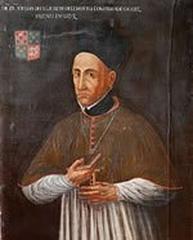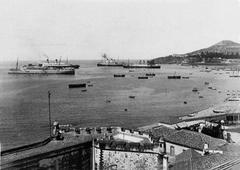
Forte de São José Visiting Hours, Tickets, and Funchal Historical Sites Guide
Date: 04/07/2025
Introduction
Forte de São José, perched on the rocky islet of Pontinha at Funchal’s harbor entrance, is a remarkable testament to Madeira’s maritime history and strategic Atlantic significance. Originally built in the 18th century to defend Funchal against pirates and foreign incursions, it features robust basalt stone walls and panoramic harbor views. The site is historically significant as the landing place of Portuguese explorers João Gonçalves Zarco and Tristão Vaz Teixeira in 1419, marking the beginning of Madeira’s colonization and its emergence as a key transatlantic hub. Over time, the fort has served as a military bastion, British headquarters during the Peninsular War, and, more recently, as the focus of the micronation “Principality of Pontinha.” This guide details the fort’s history, architecture, visiting hours, tickets, accessibility, and related attractions to help you make the most of your visit (Visit Madeira; Principality Pontinha; Nomads Travel Guide).
Historical Overview
Early Foundations and Strategic Importance
The islet of Pontinha, where Forte de São José stands, was the first landfall of Madeira’s Portuguese discoverers in 1419 (Visit Madeira). Its location soon made it a strategic defensive point as Funchal grew into a bustling Atlantic port. From the 15th through 18th centuries, the port was vital for the sugar, then wine, and later coal trade. The fort’s construction in the mid-18th century reinforced Funchal’s defenses against piracy and foreign threats.
Royal Decree, Private Ownership, and the Principality
A unique chapter in the fort’s history began in 1903, when a royal decree from King Dom Carlos I authorized the sale of part of the fort to Cândido Henrique de Freitas, making it the only territory ever sold by Portugal (ilheu-da-pontinha-principado.org). In recent years, this has inspired the quirky “Principality of Pontinha” micronation project, drawing international curiosity and adding a layer of intrigue to the site (Principality Pontinha).
Defensive, Military, and Political Roles
Forte de São José formed part of a network of fortifications protecting Funchal, including the Fortress of São Tiago and the Fortress of São João Baptista do Pico. During the Peninsular War (1801–1807), it served as British headquarters and later a prison, highlighting its strategic importance in European conflicts (Visit Madeira). With the advent of modern port infrastructure in the late 19th century, the fort’s military role diminished, but its historical significance only grew.
Architecture and Site Layout
- Structure: The fort occupies about 172.8 square meters, with irregular contours following the natural rock of the islet. Its thick basalt walls, parapets, bastions, and a fortified gatehouse were designed for defense and surveillance.
- Interior: Inside, the fort is functional, featuring former barracks, storage areas, and lookout posts. Restoration efforts have preserved both original features and later adaptations.
- Access: The Caminho Real, constructed after a 1776 royal decree, links the islet to Madeira’s main island and is one of the island’s oldest preserved paths (Principality Pontinha).
Visiting Forte de São José
Visiting Hours
- Tuesday–Sunday: 10:00 AM – 6:00 PM (last entry 5:30 PM)
- Closed: Mondays and select public holidays
- Note: Hours may vary during special events or festivals. Always confirm in advance (Visit Madeira).
Tickets and Admission
- Adults: €5
- Seniors/Students: €3
- Children under 12: Free
- Guided Tours: Included in admission or may have a small extra fee; available in several languages.
- Booking: Purchase tickets on-site or through official tourism websites. Advance booking is recommended during events.
Accessibility
- Wheelchair Access: Paved paths and ramps at the main entrance. Some upper areas and battlements may be inaccessible to wheelchairs due to historic staircases.
- Assistance: Staff are available to help; visitors with special needs should call ahead.
Getting There
- Location: Southern edge of Funchal, walking distance from the city center, the Mercado dos Lavradores, and Funchal Marina.
- Transport: Accessible by public transport, taxi, or on foot. Limited parking nearby.
Visitor Experience
What to Expect
- Panoramic Views: Stunning outlooks over Funchal’s harbor and the Atlantic.
- Architecture: Explore original ramparts, cannons, interconnected rooms, and the historic Caminho Real.
- Interpretive Materials: Informative displays, audio guides, and interpretive panels explain the fort’s evolution.
- Amenities: Restrooms, a small gift shop, and a café with light refreshments.
Guided Tours
- Duration: 30–60 minutes
- Languages: Multiple, with knowledgeable local guides
- Content: Covers military history, architectural features, key events, and the fort’s modern-day cultural role.
Events and Local Integration
Maritime Celebrations
Forte de São José is central to Funchal’s major events, including the Atlantic Festival fireworks and New Year’s Eve celebrations, where its silhouette forms a dramatic backdrop (Madeira Tourist Events). The fort participates in cultural festivals, art exhibitions, and historical reenactments.
Archaeological and Cultural Initiatives
Recent research by CEAM has uncovered historical artifacts at the site, and plans are underway for an on-site museum. The fort’s private owner supports community engagement through tours, storytelling, and educational events (Principality Pontinha).
Nearby Attractions
- Fortaleza de São Tiago: A larger 17th-century fort, now hosting contemporary art exhibitions.
- Fortaleza de São João Baptista: Another key defensive structure in Funchal.
- Mercado dos Lavradores: Funchal’s bustling farmers’ market.
- Municipal Garden: Lush green space near the harbor.
Combine these sites for a comprehensive exploration of Funchal’s history (Nomads Travel Guide).
Practical Tips
- Best Times: Early morning or late afternoon for fewer crowds and optimal lighting.
- Footwear: Wear sturdy shoes due to uneven ground.
- Weather: Madeira’s mild climate is pleasant, but sun protection is advised.
- Photography: Permitted, though drones and tripods may be restricted.
- Souvenirs: Local crafts and books are available at the gift shop.
Sustainability and Preservation
Forte de São José is maintained through collaboration between heritage organizations and Funchal’s municipality. Visitor respect and support are vital for ongoing preservation—please follow site guidelines and consider participating in educational programs or making donations (Visit Madeira).
Frequently Asked Questions (FAQ)
Q: What are the opening hours?
A: Tuesday–Sunday, 10:00 AM – 6:00 PM; closed Mondays and public holidays.
Q: How much is admission?
A: €5 for adults, €3 for seniors/students, children under 12 free.
Q: Is the fort accessible for people with disabilities?
A: Some areas are accessible; upper battlements may be challenging. Contact ahead for assistance.
Q: Are guided tours available?
A: Yes, included or for a small extra fee. Available daily in several languages.
Q: Can I take photos?
A: Yes, except where otherwise indicated.
Q: Is parking available?
A: Limited near the harbor; advisable to use public transport or walk from the city center.
Visuals and Media
- Photo Suggestions:
- “Forte de São José visiting hours – panoramic view of fort and Funchal harbor”
- “Historic basalt walls and cannons at Forte de São José”
- “Guided tour group on Caminho Real at Forte de São José”
- Maps & Virtual Tours:
- Available via Visit Madeira and official tourism sites.
Plan Your Visit
Forte de São José combines military history, stunning views, and vibrant local culture. Whether you’re a history lover, festival-goer, or casual tourist, this fort offers a memorable experience. Download the Audiala app for guided tours and insider tips, follow us on social media, and check local event calendars before your visit.
Related Links
- Funchal Official Tourism Website
- Madeira Maritime Heritage Sites
- Guided Walking Tours in Funchal
- Madeira Tourist Events
- Principality Pontinha
- Forte de São José History and Royal Decree
Conclusion
Forte de São José stands as a living monument to Madeira’s layered history, from early exploration and colonial trade to modern-day cultural celebrations. Its stone ramparts and commanding harbor views embody the island’s spirit of resilience and adventure. Plan ahead, explore nearby attractions, and immerse yourself in the stories and scenery that make this fort a must-see destination in Funchal. By supporting preservation efforts, you help ensure this unique site endures for future generations.



